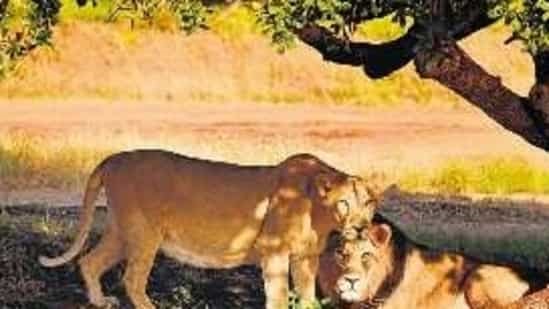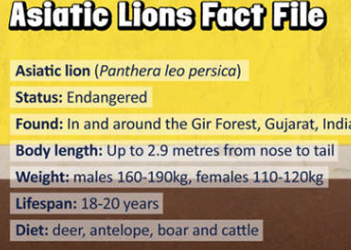Description

Disclaimer: Copyright infringement not intended.
Context: The Gujarat government has proposed a second home for Asiatic lions in Gujarat at Barda Wildlife Sanctuary, about 100km away from their present home at Gir National Park, finally pushing ahead with a long-delayed plan to move some lions from their only and very crowded home in the country, a move that would also protect the population from diseases.
Details:
About Barda:
- Barda Wildlife Sanctuary is located in Gujarat, India.
- Previous to its 1979 establishment as a wildlife sanctuary, Barda was a private reserve for Porbandar and Jamnagar.
- There are two rivers, Bileshvary River and Joghri River, and two dams, Khambala and Fodara
- There are several forest sub-types, such as southern tropical forest, southern dry mixed deciduous forest and northern tropical thorn forest, while other predominant flora include Euphorbia scrub, dry deciduous scrub, and dry bamboo brakes.
- The sanctuary area supports around 750 ‘maldhari’ families in 68 ‘nesses’.
- Important fauna are blue bull, chinkara, blackbuck, and wolf.
- While Barda was known to have had a population of Asiatic lions, they deserted the area towards the end of the nineteenth century.
About Gir:
- Besides Africa, Gir National Park in Gujarat is the only place in the world where you can spot lions roaming free in the wild.
- The Government notified the large geographical extent of Sasan Gir as wildlife sanctuary on 18th September, 1965 in order to conserve the Asiatic Lion.
- It covers total area of 1412 square kilometers of which 258 Km forms the core area of the National Park. Indiscriminate hunting by the people of Junagarh led to their decrease in population drastically, while they were completely wiped out from the other parts of Asia.
- The entire forest area of the Gir National Park is dry and deciduous which provides best habitat for Asiatic Lions.
- As per the new statics of 2015, the entire Saurashtra Region is inhabited by 523 Lions and more than 300 Leopards.
- Apart from these two animals the park is a home to two different species of Deer. The Sambar is counted largest Indian Deer. The Gir forest is also known for the Chowsingha – the world’s only four horned antelope. The Jackal, striped Hyena and India Fox are some of the smaller carnivores found in Gir Forest.
- Gir is also habitat of raptors like critically endangered white-backed and long-billed vulture, the Egyptian Vulture, the vulnerable Greater spotted Eagle and the endangered Palla’s Fish Eagle.
About Lions:
- They are confined to Gir National Park and its surrounding environs in Gujarat’s Saurashtra.In the surrounding sanctuary only Maldharishave the right to take their livestock for grazing.
- As per the 14th Asiatic Lion Census 2005, the lion population was estimated at 523 individuals. In June 2020, an estimation exercise counted 674 Asiatic lions in the Gir forest region, an increase of 29 per cent over the 2015 census figure.
- The Asiatic lion currently exists as a single subpopulation, and is thus vulnerable to extinction from unpredictable events, such as an epidemic or large forest fire.
- It is categorised as endangered on the International Union for the Conservation of Nature Red List.


|
PRACTICE QUESTION
Q) Which of the following statements is/are incorrect with reference Lions?
a. It is classified as ‘near threatened’ on the IUCN Red List.
b. Gir National Park in Gujarat is the only place in the world where you can spot lions roaming free in the wild.
- Only a
- Only b
- Both a and b
- Neither a nor b
Answer: Option 3
|
https://www.hindustantimes.com/india-news/gujarats-barda-pitched-as-new-home-for-lions-to-be-moved-from-gir-101678818942547.html














